FACTORS AFFECTING CUSTOMER SATISFACTION IN GROUP BUYING IN VIETNAM
Bạn đang xem bản rút gọn của tài liệu. Xem và tải ngay bản đầy đủ của tài liệu tại đây (952.08 KB, 83 trang )
UNIVERSITY OF ECONOMICS HO CHI MINH CITY
International School of Business
------------------------------
Nguyen Thi My Chi
FACTORS AFFECTING CUSTOMER
SATISFACTION IN GROUP BUYING IN
VIETNAM
MASTER OF BUSINESS (Honours)
Ho Chi Minh City – 2013
UNIVERSITY OF ECONOMICS HO CHI MINH CITY
International School of Business
------------------------------
Nguyen Thi My Chi
FACTORS AFFECTING CUSTOMER
SATISFACTION IN GROUP BUYING IN
VIETNAM
ID: 60340102
MASTER OF BUSINESS (Honours)
SUPERVISOR: Dr. Tran Ha Minh Quan
Ho Chi Minh City – 2013
- i -
ABSTRACT
Recently, group buying model is developing rapidly and impressively in
Vietnam as a type of online shopping. This study aims at investigating the
motivations that influence customer satisfaction as well as service quality of group
buying. This research will find out that service quality, brand, trust and price are
critical factors influenced customer satisfaction with service quality is the most
important factor.
Keywords: group buying, group buying site, customer satisfaction.
- ii -
TABLE OF CONTENTS
ABSTRACT ................................................................................................................ i
TABLE OF CONTENTS ........................................................................................... ii
LIST OF FIGURES................................................................................................... iv
LIST OF TABLES ......................................................................................................v
I. INTRODUCTION ...................................................................................................1
1. Research background ...........................................................................................1
2. Research motivation ............................................................................................3
3. Research questions ...............................................................................................4
4. Research objectives .............................................................................................4
II. LITERATURE REVIEW .......................................................................................4
1. Group buying .......................................................................................................4
2. Service quality .....................................................................................................6
3. Online service quality ..........................................................................................8
4. Service quality and customer satisfaction .........................................................11
5. Price discount and customer satisfaction ...........................................................12
6. Trust and customer satisfaction .........................................................................13
7. Brand and customer satisfaction ........................................................................13
8. Research framework ..........................................................................................14
III. RESEARCH METHODOLOGY ........................................................................16
1. Research process ................................................................................................16
2. Research sampling method ................................................................................18
3. Measurement scales ...........................................................................................19
4. Data collection procedure ..................................................................................21
5. Data analysis method .........................................................................................21
5.1. Descriptive analysis .....................................................................................21
5.2. Reliability analysis ......................................................................................22
- iii -
5.3. Exploratory Factor Analysis (EFA) ............................................................22
5.4. Multiple regression analysis ........................................................................23
IV. FINDING AND ANALYSIS ..............................................................................24
1. Sample description .............................................................................................24
2. Evaluation and refinement of measurement scales ............................................27
2.1 Cronbach Alpha Reliability Analysis ...........................................................28
2.2. Exploratory Factor Analysis (EFA) ............................................................30
2.2.1. EFA for independent variables .............................................................30
2.2.2. EFA for dependent variable ..................................................................37
2.2.3. Pearson Correlation Coefficient ............................................................38
3. Hypotheses testing .............................................................................................39
3.1. Testing assumptions of Multiple Regressions .............................................39
3.2. Regression analysis .....................................................................................41
3.3. Summary of hypotheses testing results .......................................................42
4. Discussions of the findings ................................................................................43
V. CONCLUSIONS AND IMPLICATIONS ...........................................................45
1. Conclusion .........................................................................................................45
2. Implications of this research ..............................................................................45
3. Research limitations and implications for future research ................................47
REFERENCES ..........................................................................................................49
APPENDIX A ...........................................................................................................54
APPENDIX B ...........................................................................................................60
APPENDIX C ...........................................................................................................66
APPENDIX D ...........................................................................................................68
APPENDIX E............................................................................................................70
APPENDIX F ............................................................................................................71
- iv -
LIST OF FIGURES
Figure 2.1 The research model and hypotheses ........................................................14
Figure 3.1 Research process ......................................................................................17
Figure D.1 Histogram of SATIS dependent variable ................................................68
Figure D.2 Normal P-P Plot of regression standardized residual .............................68
Figure D.3 Scatterplot ...............................................................................................69
- v -
LIST OF TABLES
Table 3.1 Survey item summary ...............................................................................20
Table 4.1 Sample characteristics ...............................................................................24
Table 4.2 Cronbach’s alpha reliability test result .....................................................28
Table 4.3 KMO and Bartlett’s Test for independent variables .................................30
Table 4.4 Rotated Component Matrix .......................................................................31
Table 4.5 Removal process during EFA ...................................................................32
Table 4.6 Total Variance Explained..........................................................................33
Table 4.7 Rotated Component Matrix .......................................................................34
Table 4.8 Cronbach’s alpha summary after EFA ......................................................36
Table 4.9 KMO and Bartlett's Test for dependent variable ......................................37
Table 4.10 Factor loading of satisfaction variable ....................................................37
Table 4.11 Pearson correlation coefficients between SATIS and other independent
variables ....................................................................................................................38
Table 4.12 Coefficientsa ............................................................................................40
Table 4.13 The summary of overall value ................................................................41
Table 4.14 ANOVAa result .......................................................................................41
Table 4.15 The result of testing hypotheses ..............................................................42
Table C.1 Pearson correlations .................................................................................66
Table E.1 Descriptive Statistics ................................................................................70
Table F.1 Measurement scales ..................................................................................71
- 1 -
I. INTRODUCTION
In the first chapter, the background of the chosen research subject will be
presented, along with problem background and the purpose of this thesis. Finally,
the research question will be addressed with the research objectives which will be
clarified clearly in later parts.
1. Research background
In the past, consumers must go to the store and buy commodities directly. It
takes much times and also brings the inconvenience to consumers, especially who
are far away from the store. Nowadays, as the Internet has been developing, more
buyers are enjoying online shopping because the Internet services are as a
convenient way to shop. Consumers can buy goods, even services, online, where
makes more options for them. Consumers who have a want for some favor services
or goods could be gathered when making an online shopping (J. Chen, Chen, &
Song, 2002; Pi, Liao, Liu & Lee, 2011). Additionally, it offers many advantages,
such as facility, rapidity, a 24-hour opening and unrestricted geography.
Due to the advantages of Internet, in the context of electronic commerce,
online group buying becomes more and more popular. According to Rezabakhsh et
al. (2006), “central idea of online group-buying is the aggregation of geographically
dispersed consumer purchasing power from all over the countries that have a
common interest in a certain product and come together on the group-buying sites to
get price discounts”. In addition, joining online group buying, consumers not only
get competitive advantages of quantity system price and delivery service, but also
have chances to share shopping experiences with other buyers.
- 2 -
In Vietnam, according to electronic information website Maskonline, website
phagia.com appeared officially on June 2010, making an underground river to the
field of electronic commerce in the country. Some months later, many other group
buying sties were born to compete each other, as cungmua.com, muachung.vn,
nhommua.com, etc. According to Vu Hong Quang, a representative of the Southern
VC Corp. which owns muachung.com, after just 7 months of operation, his site
already has 100.000 members. Muachung.com’s main competitor, nhommua.com
has the same number of registered users but even some of the newer sites have
60.000 members. According to uncompleted statistics, up to now, Vietnamese
market has about 97 sites that offer group buying services (E-Money, 2011).
Deals sites can create a winning situation all around that give benefit to three
sites: business, coupon site and consumer. Businesses get some much needed
traffic, the coupon sites get a commission for pulling in that traffic and consumers
get a good deal. And Vietnamese are loving this model.
Group buying model adopts “tipping point” mechanism. This mechanism
requires a minimum number of participants for each deal. There are two conditions
make a transaction happens: the number of actual participants exceeds the minimum
number and the potential buyers have prepaid for the deal (Cohen, 2009). A deal
usually includes price discount of the product or service. When the number of
people reaches a certain limitation, customers will get direct discounts on goods or
services or they can buy vouchers with attractive prices (E-Money, 2011).
According to action.vn, group buying model is as a balloon inflated round
two years ago, but it is now flat and gradually has to transform to survive (May
2012). Even Groupon in the U.S., the first group buying model in the world, also
had bitterly announced dismal sales declines in the last 6 months. In Vietnam, the
- 3 -
group buying model is facing to changes to overcome this difficult period. In the
past, the majority of the initiators were main buyers in online group buying.
However, because of the impact of global economic recession, many initiators are
aggressive being the roles of vendors holding the products or services to supply to
consumers. This research doesn’t focus on analyzing the reason why initiator acts as
vendor, however, vendor role of initiator is considered as a part of group buying
mechanism to evaluate service quality later.
2. Research motivation
Kris Ashton (2011) noted that, since many consumers are not familiar or
comfortable with online payments, most vouchers are purchased by money transfer
or cash on delivery. Vouchers are often lost or delivered lately and the cost of
delivery can be costly. There is also the problem of many merchants that don’t
follow the rules of the contract, provide inferior service or treat voucher holders
differently than they do customers that are paying full price. Summarily, they are all
problems in service quality that group buying services need to focus more to survive
in recent difficult environment.
In previous studies, some of them discussed online group buying in operator
point of view: Wei et al. (2011) proposed a management model in online group
buying’s process, Matsuo (2009) proposed an effective pricing mechanism for
traders, Anand and Aron (2003) using analytical economic models to study the
phenomenon of online group buying. The other discussed from consumer point of
view: Liao et al. (2012) focused on consumers’ demands and preference of stuff in
online group buying, Tsai et al. (2011) found out that trust in virtual community and
website quality are the determinants of online group buying’s intention, etc.
- 4 -
As the review above, there is no study focus on service quality of group
buying even it is the critical factor affecting customer satisfaction. Therefore, this
research will try to figure out how to measure service quality of a group buying
service toward customer satisfaction. It also provides the main factors along with
service quality to enhance customer satisfaction of group buying service.
3. Research questions
According to the research background and motivations outlined before, this
research aims to investigate the following questions from the experiences of buyers
in online group buying:
(1) What are online service quality dimension in group buying service and
how do they affect customer satisfaction?
(2) What are factors that affect customer satisfaction in Vietnamese group
buying service and how do they affect to customer satisfaction?
4. Research objectives
The main objective of this research is to investigate the usefulness and
applicability of theoretical model in measuring online group buying quality and
customer satisfaction:
- Analyze the method used to measure service quality of group buying and
the influence of the measure to customer satisfaction.
- Analyze factors influencing customer satisfaction in group buying in
Vietnam.
- 4 -
II. LITERATURE REVIEW
In this chapter, some literatures are reviewed concerning the online service
quality. This research will continue by presenting some popular scales such as
SERVQUAL and E-S-QUAL. Finally, the purposed research model for the adoption
of the group buying will be presented.
1. Group buying
Nowadays, multiple types of electronic commerce have been developing
strongly. Group buying is one of those diversified types, and has made an
impressive speed of progression in recent years (Matsuo, 2009). Group buying (i.e.
collective buying, group purchase) has existed in marketplaces for several decades.
It is defined as the purchase from a group of consumers who seeks to get products
or services at the cheapest price but in the best quality. Group buying model can
help many buyers gather into collective buying groups, even though they are not
near or they do not know each other (Kittipong et al., 2011).
In the past, members of group buying were restricted. They could only ask
for the person who they are familiar with to join group buying (Liao et al., 2012).
Yuan (2004) also pointed out that the main reason of this issue is the difficulty in
finding a group of people with the same demand all the time in traditional markets.
Therefore, one of advantages of online group buying is that many buyers can form
groups on the Internet in a short period of time and buy goods or services at a
discounted price even if they don’t know each other (Matsuo, 2009). Besides,
geographical limitations are also a problem in traditional market (Liang & Lim,
2011). However, with the growth of Internet, consumers with the same interests can
converge together easily through Internet without any difficulty as they meet
- 5 -
directly (Yuan, 2004). Thus, the other advantage of online group buying is that
online group buying can overcome the geographical limitations that the traditional
group buying could not do like that.
Erdogmus and Cicek (2011) mentioned that there are two different types of
online group buying systems: dynamic pricing and stable pricing. In the dynamic
pricing type, the discount prices can be changed basing on the price-quantity tables
defined by the sellers. If in a predetermined time, a group of buyers could be
gathered, then consumers could get the product or service at the same discounted
price.
In the second type of the online group buying, stable pricing, “the seller
offers a certain product or service at a large discount price, but the price is static,
does not get lower as the number of the buyers increases (Erdogmus & Cicek, 2011,
p.309)”. However, the discount price is only applied when the total number of the
buyers who buy the deal is greater than the predetermined limit of the minimum
required number of buyers. Due to the second type of online group buying is a new
form of marketing at the connection of promotion and pricing and grows rapidly
(Erdogmus & Cicek, 2011), as well as it is more popular in Vietnam than the first
type, this research will focus on the context of the second type of online group
buying.
According to Zhou (2005) and Chen (2007), there are two roles in the online
group buying chain. One is main buyer or it is also called initiator. The
responsibilities of main buyer are that he/she posts the issue about the requirement
of group buying, and then calculates the qualities of demand as well as price to
order the products which are buyers expected. The other role is follower who is
- 6 -
gathered in a group by main buyer. Follower is mostly consumer in online group
buying chain.
Lai (2002) pointed out one new facet of group buying model. Recently, due
to the economic situation on the world, the role of initiator in group buying is able
to be a main buyer or a seller. Initiator can buy good or service from supplier or
vendor, then sells vouchers to consumers, or initiator can sell good or service
directly to consumers. As a result, correspond to the second type of group buying,
initiators here are the voucher suppliers, sometimes are the product vendors also.
Consequently, in this research, service quality of group buying will be
examined throughout the process from buyers (consumers) start to buy
vouchers/services from initiators till consumers finish using services or get the
products.
2. Service quality
In this part, some definitions and dimensions of service quality are reviewed
for the purpose of choosing the suitable measurement for the research. Firstly,
Parasuraman et al. (1988) defined service quality as the ability of the organization
to meet or exceed customer expectations. However, there is the difference between
customer expectations of service and perceived service (Zeithaml et al., 1990).
Zeithaml et al. (1990) explained that perceived service quality derives from
comparisons of customer expectations with their perceptions of service delivered by
the suppliers. If expectations are greater, then perceived quality is less than
satisfactory and hence customer dissatisfaction occurs (Parasuraman et al., 1985;
Lewis and Mitchell, 1990).
- 7 -
In the past, many studies have attempted to discover the global or standard
dimensions of service quality such as Parasuraman et al., 1985, 1988; Paulin and
Perrien, 1996; Pitt et al., 1999; Sasser et al., 1978. Among them, Parasuraman et
al.’s (1985) research has been the most prominent because of its affect on other
researches later on. Through a series of focus group sessions, that study uncovered
ten dimensions of service quality that are generic and relevant to services in general:
tangibles,
reliability,
responsiveness,
communication,
credibility,
security,
competence, courtesy, understanding the customer, and access.
Later, these ten dimensions were improved and reduced to five dimensions:
tangibles, reliability, responsibility, assurance, and empathy (Parasuraman et al.,
1988). Then, a new global measurement for service quality, SERVQUAL was
developed by Parasuraman et al. (1988) basing on those five dimensions. After that,
many researchers use the SERVQUAL scale to measure the service quality not only
in a specific industry but also in various service industries such as hospital, food,
train ticket, etc.
Anyway, SERVQUAL measurement is not a perfect scale in all cases.
Because the SERVQUAL measurement does not include the unique facets of online
service quality as one prior study pointed out, such as customer-to-Web-site
interactions, since this instrument was constructed based mainly on customer-toemployee interactions. At the beginning, the five dimensions of SERVQUAL were
found to be valid in the traditional service market. However, when some academic
researchers applied the SERVQUAL scale to measure e-service quality, it has been
considered problematic and may not be quite appropriate. The reason is that there
are some differences between e-service and traditional service in some aspects, such
as the absence of sales staff, the absence of traditional tangible element, and selfservice of customers. As a result, the SERVQUAL is not suitable for measuring e-
- 8 -
service quality, and it is meaningful to renovate SERVQUAL scale into a new
valuable instrument for measuring e-service quality. Below part will review some
online service quality dimensions which are developed from this scale.
3. Online service quality
Parasuraman et al. (2002) defined online service quality as the extent to
which a website facilitates efficient and effective shopping, purchasing, and
delivery. We can recognize that it includes broadly all phases of a customer’s
interactions. Santos (2003) argues that online service quality is an overall customer
assessment and judgment of online service delivery in the virtual marketplace. It is
much easier for customers to compare different service offerings than through
traditional channels (Santos, 2003). In this study, service quality provided by group
buying sites – a special type of retail web sites – is focused on. Because the
definition of e-service quality by Parasuraman et al. (2002) cares almost enough
phases of online service, so it has been used by many researchers, and it is also
applied for the context of this study in building a conceptualization of online service
quality.
Yang (2001) considered service quality as an important factor to decide the
success of online retail businesses because it influences to consumers’ online
shopping experiences. The result of one empirical evidence of Kim et al. (2006)
proved that poor service quality would affect online retailers negatively. When
online shoppers don’t believe in shopping and handling charges, over 60 percent of
them will exit before completing the buying transaction. For example, incomplete
product information (e.g. missing links and non-working buttons) leads to customer
frustration and in turn to existing. Nonetheless, some online retailers lose a valuable
- 9 -
opportunity to build customer loyalty because of poor service quality (Wachter,
2002).
Besides online service quality becomes a hot topic in research field,
measuring and monitoring online service quality in the virtual world are also
considered as an importance. Many researchers have already built online service
quality measurement basing on analyzing its dimensions. For example, Dabholkar
(1996) conducts a research work on the dimensions of e-service quality focusing on
website design, reliability, delivery, ease of use, enjoyment and control. Next, Yoo
and Donthu (2001) develop SITEQUAL scale to measure online service quality of
website including the four dimensions: ease of use, aesthetic design, processing
speed, and interactive responsiveness. Compare with the traditional dimensions of
service quality, Cox and Dale (2001) proposed six new dimensions of online
retailing
service
quality,
including
website
appearance,
communication,
accessibility, credibility, understanding and availability.
As we can recognize, these scales just focus on evaluating web site quality
such as design, usage and performance. It lacks of information about service
attributes completely. In addition, web site quality is just a small part in the service
quality chain of group buying model. Group buying must pay attention to other
attributes to satisfy customers besides web site quality. For example, the four
dimensions of SITEQUAL by Yoo and Donthu (2001) do not capture all aspects of
the buying process, and thus do not provide a comprehensive evaluation of a site
(Parasuraman et al., 2005).
From limitations of measuring online service quality in above analyses, in
2005, it is the first time the meaning of service is comprehensive in a research of
Parasuraman et al. because it contains all aspects of online service, in which pre-
- 10 -
and post- web site service are described. About the measure of online service
quality, the one used in that research of Parasuraman (2005) named E-S-QUAL
includes all phases of a customer’s interactions with a website. There are four
dimensions of E-S-QUAL: efficiency, fulfillment, system availability and privacy.
In addition, Parasuraman et al. (2005) also developed an e-recovery service quality
scale as long as E-S-QUAL named E-RecS-QUAL as a subscale for problem
resolution with three dimensions: responsiveness, compensation and contact.
From that time, E-S-QUAL and E-RecS-QUAL become an instrument to use
popularly because of their strong effects on customer satisfaction. However,
according to Kim et al. (2006), the compensation dimension in this instrument
cannot be measured without actual problems to resolve, and then this dimension
will be eliminated from the model used in this research. Summarily, this research
will measure service quality of group buying by totally six dimensions:
- Efficiency: the ease extent that customers can access and use the website in
purchasing transactions.
- Fulfillment: the extent that the site can keep its promises about order
delivery and item availability.
- System availability: the availability of the website whenever customers
would like to access without functioning problems such as missing links, nonworking buttons.
- Privacy: the safety extent that the site can protect customer information.
- Responsiveness: the effective control ability of the site when facing up to
problems and returns from customers.
- Contact: the support availability of the site whenever customers need to
contact.
- 11 -
4. Service quality and customer satisfaction
According to Spreng and Mackory (1996), service quality and customer
satisfaction are inarguably the two concepts that are so difficult to explain in
marketing theory and practice. In 2001, Yang argued that when comparing the
performance of a product or service with their expectations before purchasing, if it
exceeds the expectation, the satisfaction of customers would be increased. However,
four years later, Saha and Zhoa (2005) gave out a new definition of satisfaction like
“a collective outcome of perception, evaluation and psychological reactions to the
consumption experience with a product or service”.
The appraisal-emotional response-coping attitudinal framework of Bagozzi
(1988) thought that service quality is a construct oriented to awareness, while
satisfaction is an emotional construct. It is the reason that many researchers
suggested service quality is an antecedent of satisfaction. After that, in 2003,
Woldfinbarger and Gilly discovered a positive relationship between overall service
quality and satisfaction in case of fixed web retailing; also, Montoya-Weiss et al.
found out an evidence to prove the relationship between service quality and
satisfaction by analyzing the determinants of online channel preference for a multichannel service provider.
One of the targets of research question in this study is that to define how
service quality dimensions affect to customer satisfaction. Yang et al. (2004) has a
study about online service quality dimensions and their relationships with
satisfaction. At the result, it confirms that the most often-cited service quality
dimensions leading to customer satisfaction are: responsiveness, ease of use
(efficiency) and service reliability (fulfillment). Yang and Tsai (2007) also have a
research that measure the affect level of E-S-QUAL scale on customer satisfaction
- 12 -
and confirmed that the factors representing efficiency, fulfillment and
responsiveness have the strongest effects, followed by contact and then privacy.
Moreover, according to Kim et al. (2006), a website needs to contain many different
browser functionalities although system availability dimension is found to make a
strong impact on customer evaluation, otherwise it may lead to customer frustration
and dissatisfaction. From these points of view, we can extract the summary that
there is relationship between E-S-QUAL scale of online service quality and
customer satisfaction and can build following conceptual hypotheses:
H1a: Efficiency has a positive impact on online customer satisfaction.
H1b: Fulfillment has a positive impact on online customer satisfaction.
H1c: System availability has a positive impact on online customer
satisfaction.
H1d: Privacy has a positive impact on online customer satisfaction.
H1e: Responsiveness has a positive impact on online customer satisfaction.
H1f: Contact has a positive impact on online customer satisfaction.
Especially, in this research, customer satisfaction was defined as the overall
evaluation in the consumption experience of product or service after the customer
used the group buying website.
5. Price discount and customer satisfaction
The most benefit that group buying service can give customers is discounted
price. Group buying sites must provide buyers with rare resources which the buyers
could not get from any other online purchasing sites (Kittipong et al., 2011). People
come to group buying sites and buy product or service if they could find a cheaper
and more reasonable price compared to other sites. When the buyer perceives that
- 13 -
with the cheaper price, they could still get the valuable product or service, the price
satisfaction of the buyer is increased, and he or she is more likely to join and
purchase on group buying sites. Thus, price is considered as a hypothesis to
analyze:
H2: Price discount has a positive impact on online customer satisfaction.
6. Trust and customer satisfaction
Many prior studies considered that trust was a critical factor for customers to
create and keep relationships with vendors (Deng, Lu, Wei & Zhang – 2010).
Kauffman, Lai & Lin (2010) has a new concept to define trust. There are two people
that related to trust definition: trustor and trustee. When trustor believe that trustee
is sincere and honest, and will not try to harm or trick trustor, leading to tangible or
intangible damage, it means that trustor gives trust to trustee. For example, when a
customer trusts a service or good provider, customer will expect to raise satisfaction
and loyalty towards the vendor (Kassim & Abdullah, 2008). As a whole, if
customer does not trust the vendor, customer will possibly be dissatisfied with that
vendor. Deng et al. (2010) & Kim et al. (2009) think that trust will affect to
satisfaction in long term. Hence, we have this hypothesis:
H3: Trust will positively affect customer satisfaction toward group buying
service.
7. Brand and customer satisfaction
Today, brand is the official introduction of the company and the product that
company provides customers. According to Mowen (2001), brand is a promise or a
set of guidelines that reflects the image of a company, it makes customer think of
- 14 -
what the company does. Brand gives the specific value to bring the company to the
market, therefore it distinguishes the company from others.
Hammond (1999) supposed that branding is a relationship that was built on
understanding and satisfaction. For example, when customers know about a famous
brand of product well, they tend to be satisfied with that product when purchasing in
that group buying site rather than other sites that have other brands of this product.
Therefore, this research proposes one more hypothesis:
H4: Brand of product or service will positively affect customer satisfaction in
group buying service.
8. Research framework
Base on above literature reviews, the relationship between factors affect to
customer satisfaction and customer satisfaction is briefly described in the figure 2.1:
Group buying
service quality
Efficiency
H1a
Fulfillment
System
availability
Privacy
H1c
Price discount
H1b
H1d
Customer
satisfaction
H3
Trust
H4
H1e
Responsiveness
H2
H1f
Contact
Figure 2.1 The research model and hypotheses
Brand
- 15 -
The hypotheses of this research include:
H1a: Efficiency positively relates to online customer satisfaction.
H1b: Fulfillment positively relates to online customer satisfaction.
H1c: System availability positively relates to online customer satisfaction.
H1d: Privacy positively relates to online customer satisfaction.
H1e: Responsiveness positively relates to online customer satisfaction.
H1f: Contact positively relates to online customer satisfaction.
H2: Price discount positively relates to online customer satisfaction.
H3: Trust will positively affect customer satisfaction toward group buying
service.
H4: Brand of product or service will positively affect customer satisfaction in
group buying service.
- 16 -
III. RESEARCH METHODOLOGY
This chapter presents brief description of the research methodology used for
the research. This includes the research process, research measurement, sample
selection methods, data collection methods and data analysis methods.
1. Research process
Due to the underlying study, the researcher has simply chosen quantitative
approach for achieving the purpose of the study. Quantitative research approach is
based on the development of testable hypotheses and theory. Base on idea of
Kenova and Jonnasion (2006), quantitative investigations tend to measure “how
often” or “how much”. Through utilizing this method, the researcher would measure
service quality and the level of customer satisfaction in group buying in Vietnam.
To collect the quantitative data, the survey method has been used and eventually the
data has been analyzed by using statistical techniques.
The research process of this study is described in the figure 3.1.
- 17 -
Research problem
Research objective
Research scope
LITERATURE REVIEW
Research model
& hypotheses
Questionnaire
development
RESEARCH DESIGN
Pilot study with face-to-face
interview (n = 10)
Sampling
design
Refine measures &
measurement scale
Refine
questionnaire
Main survey
DATA ANALYSIS
Reliability testing
(Cronbach’s alpha)
Validity
testing
(EFA)
Hypothesis
testing
(regression)
Conclusion and implication
Figure 3.1 Research process
Firstly, research problem was defined, and then research objective and
research questions were identified to be the target of solving defined research









